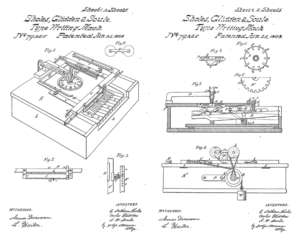A Short Short History of the Typewriter
In the mid-1900s, Christopher Latham Sholes, a journalist and politician, along with mechanic Carlos S. Glidden and printer Samuel W. Soule, came up with a design for a typewriter. It wasn’t the first; in the 1600s, for example, an Italian printmaker invented a device to put letters onto paper and in the 18th century a Brit created a machine that vaguely resembled a typewriter. But on Sholes, Glidden, and Soule’s original patent application, the drawings looked more or less like what we think of as a typewriter today except for one detail: instead of a conventional keyboard it had piano keys! There were 21 on the application but the prototype they submitted (inventors were required to do this) had fewer.
Soule left the project after the application was granted, and the design underwent many refinements (including the addition of a more conventional keyboard). Sholes continued working on it with Glidden until he, too, moved on and Sholes collaborated with John Densmore, an investor. By 1871, a few machines had been manufactured but no one seemed very interested, especially at the steep price of $50,000 that Densmore was quoting. In a smart marketing move, Densmore eventually sent a typewritten letter to E. Remington & Sons, a weapons manufacturer that was looking to diversify after the Civil War. Prototypes were produced by Remington’s sewing machine division. The early models were unreliable and clunky, but some recognized its potential. (Mark Twain was among the early adopters; he called it a “curiosity breeding little joker.”) As it was gradually improved and its usefulness recognized, buyers began to emerge.


